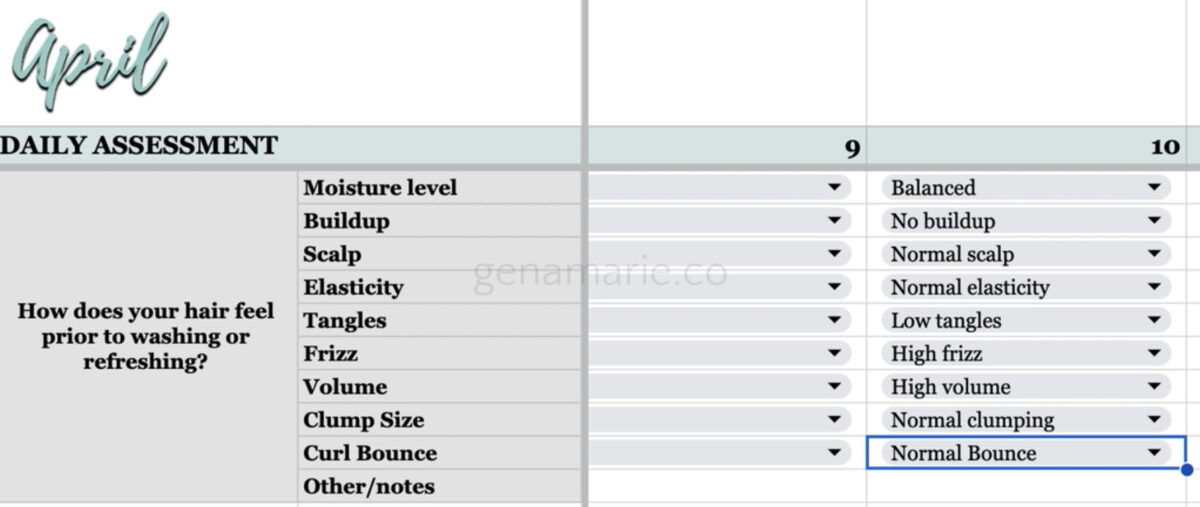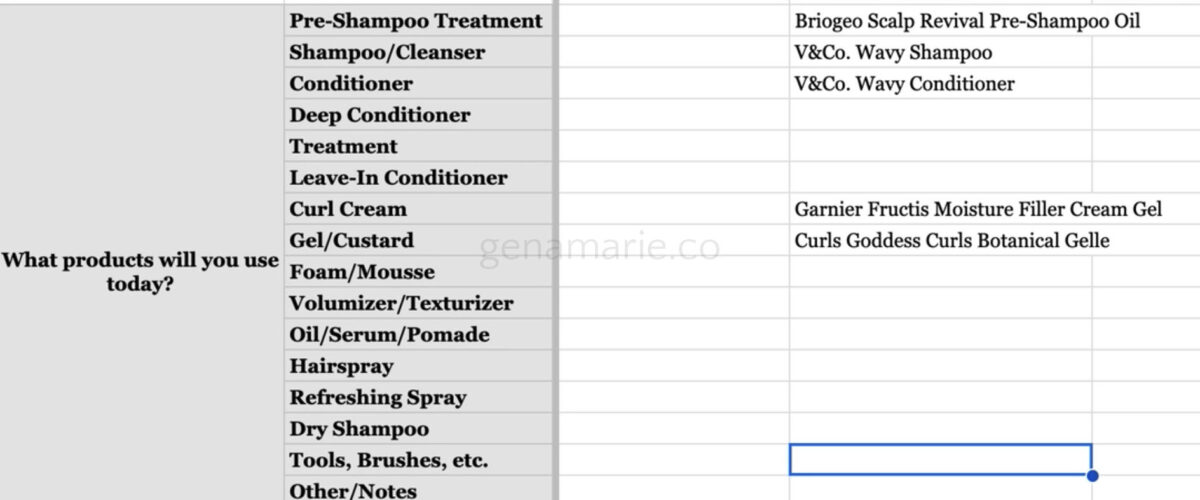
Picking Balanced Product Combos for Your Hair: Moisture vs Hold (Live)
If your curls feel soft but still frizzy… or they look great on wash day but completely fall apart after one day… there’s a good

Does your curly hair turn out differently every time you wash and style? This is common and normal, but there are some tips you can try to improve the consistency of your curly hair. In this video, I walk you through how to diagnose your hair’s needs, plan your wash day based on those needs, and track your results using my new Curly Hair Tracker & Planner.
I’m excited to announce the launch of my new digital product, the Curly Hair Tracker & Planner. If you struggle with diagnosing what your hair needs, planning your routine, and evaluating your results, this is for you.
This is not your typical spreadsheet template where you have to fill in blanks, this is a guided assessment with drop-down options and explanations for every term.
Let’s fill it in together and plan my routine today.
1. First I’m assessing how my hair looks and feels prior to washing. I selected the following answers:

2. Then I determine if I need to wash or refresh based on the answers and by using the guide on the Labels tab of the spreadsheet. I’m logging my sleep protection as well.

3. Next I plan out the products that I am going to use. I also log the number of products that contain protein to keep tabs on my protein use.

4. After I’m done drying my hair, then I like to log the styling techniques that I used in that routine. Finally, I log my results. There are questions within the spreadsheet that help you assess your results, record your thoughts, and any notes for things you would change the next time. Adding a photo to the tracker is also extremely helpful.
Continue logging your hair every day so you can document how your styling products hold up. You can also log what you do on refresh days.
When your hair is more porous, it’s going to turn out more inconsistent and be sensitive to things like the weather. The only true fix is to grow out any damage, and then properly maintain your healthy hair. In addition:
The ability to assess your hair’s needs is one of the biggest advantages of the Curly Hair Tracker & Planner. In the guide, I walk you through if you should wash or not and what to use. For example:
Use the shop page of my blog to find the right products for your hair’s needs. You can also watch my playlist on how to pick the right hair products.
When testing new products, it’s crucial to test them more than once. Curly hair is like a science experiment! Only change one variable at a time when testing. For example, if you test a gel and it doesn’t give you any hold, try it the same way again but do not use a cream or a leave-in under it. Log the routine and your results in the spreadsheet so you can see what you did when you liked your results. Include photos!
You would be surprised at how much product application and styling technique make in your results. You can use the same products different ways and your results will look much different. The tracker enables you to document those techniques and if they worked or not.
Different areas of your hair may also need different techniques. For example, the lower half of my hair is much healthier than the top so it doesn’t need much brush styling. It clumps too much sometimes. The top section, on the other hand, struggles to clump and often turns stringy and frizzy. I can focus my brush styling efforts just on the top section and save time.
Don’t ruin all that work you did on wash day by not protecting your hair while you sleep. This will help you preserve your curls so they will look more consistent in between washes. I prefer a satin pillowcase and a bonnet.
If you often forget to wear your sleep protection, make it part of your nighttime skincare routine. I put my bonnet on before I wash my face so it doubles as protection from the water when washing my face.
The biggest cause of inconsistency in your curls day-to-day is the changing weather. Unfortunately it’s impossible to completely waterproof your hair, but there are some things that can help.
Remember that inconsistency is normal and our hair will never look identical every day. It doesn’t always mean there is something wrong with your curls. If you have damage though, just know that your hair will become more consistent as the health of your hair improves.
Download the Wash Day tracker & Planner to better assess your hair’s needs, plan your routines, and track & analyze your results.
If you need more help with cycling your wash days, watch this video which includes a free Wash Day Schedule & Guide.


If your curls feel soft but still frizzy… or they look great on wash day but completely fall apart after one day… there’s a good

Most people describe their curls as dry, but what you’re seeing might not be dryness at all.Soft frizz, limp curls, dullness, and lack of definition

Light and medium-hold gels are one of the biggest categories out there — and honestly, most of them don’t work. I’ve tested hundreds of gels.

If you’ve ever felt frustrated with your hair or caught yourself thinking, “I just have bad hair,” “Nothing ever works for me,” or “My curls
2 Responses
First, thank you for helping me, I always know will give me advice that will work for my super unique hair (that’s a nice word for crazy, right?!)
A couple of questions:
1. Does your new computer washday tracking system have a place to record Dew Point and Humidity on washday. That makes a big difference for higher porosity hair like mine.
2. Where can I find your shopping guide where I can set and search by my preferences? For instance, I want to search heat protectors that do not contain glycerine or aloe. Or products that do contain protein.
Thank you for all your efforts and for sharing your expertise!
God Bless You, Debby
Hi Debby,
There is a spot to log whether it is “humid,” “mild,” or “dry.” I thought that would be simpler for people rather than getting into dew points. However, there is plenty of space for notes if you would like to log the actual dew point in your area that day. Also, note that the tracker is a spreadsheet template, so you would just need to look up the dew point such as on the Weather app then enter it on the spreadsheet.
The shop page is here: https://genamarie.co/shop/
You can always find this under the very top menu on my blog under “shop”.
Let me know if you have any more questions.
Thanks!